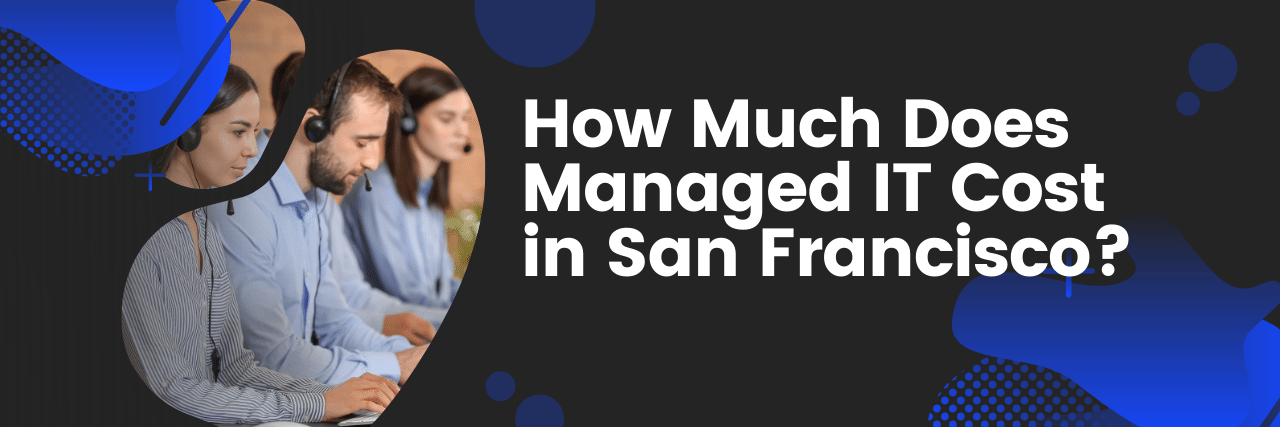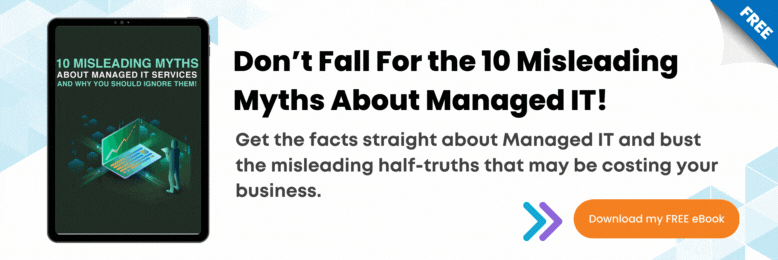How Much Does Managed IT Cost in San Francisco?
March 1st, 2022 | 7 min. read

San Francisco, California, is well-known as one of the most expensive places to live in the United States.
But does the high cost of living translate into a more expensive Managed IT service?
Luckily, no. San Francisco is saturated with IT companies; it’s the land of technological advancement, and it shows.
San Francisco has opportunities for you to negotiate deals difficult to find anywhere else.
However, a high number of Managed IT Service Providers (MSPs) doesn’t necessarily translate to straightforward pricing.
MSPs don’t always have easy-to-understand pricing because the answer to the question “How much will it cost?” often has the answer “It depends.”
A reasonable starting investment for Managed IT services is between $50 - $250/user per month + onboarding fees. But many factors affect the estimate an MSP will provide you.
There’s no one-size-fits-all cost for Managed IT. That’s why, at ITS, we always meet with clients before finalizing the investment, despite having Managed IT pricing on hand for clients to review.
In this article, we’ll be going over:
- MSPs in San Francisco vs. other locations
- Five Price Factors in Managed IT services
By the end of this article, you’ll be aware of the unique characteristics of MSPs in the San Francisco Bay Area. This, along with an understanding of the factors that go into the MSP’s price, will keep you ahead of the game when scouting out Managed IT services for your company.
MSPs in San Francisco vs. Other Locations

Shawne Albritton, Sales and Marketing admin of ITS San Francisco, has a lot of unique insight into the MSP landscape in San Francisco.
“San Francisco is its own beast, and I mean its own beast,” Albritton said. “What works in Los Angeles, Las Vegas, Detroit, Chicago doesn’t necessarily work here.”
When asked why, she explained, “You’re in the land of tech giants here in San Francisco. And when you’re surrounded with that, you really have to differentiate your MSP service offering.”
As a company looking for an ideal MSP partner in the San Francisco area, this is excellent news for you. You can find Managed IT services that are exactly right for your business. Each MSP can be ranked according to their services.
Finding the right MSP partner is a matter of diligent research.
Albritton also talked about a unique strategy that some MSPs offer.
“There are some MSPs that offer a month-to-month contract. This is flexible for the client but doesn’t necessarily lend itself to a partnership relationship. ”
This isn’t something the ITS SF branch does, as the benefits of a long-term partnership outweigh short-term contracts. It is through a long-term partnership that true value is realized, as we work to help our clients scale their businesses and leverage technology for efficiency and enhanced productivity. But, if you’re looking for an MSP, it’s worth asking if they offer something similar.
Five Price Factors in Managed IT services
What goes into the different prices of Managed IT in San Francisco? We interviewed Tom Andrulis, ITS CEO, to explain the factors of a price plan for Managed IT.
The five factors, he said, are:
- Service Time Required
- Number of users
- Number of servers
- Amount of data
- Services and Upgrades Needed
1. Service Time Needed
 Service time is how much time you and your MSP spend while fixing IT issues.
Service time is how much time you and your MSP spend while fixing IT issues.
“The amount of technical time changes from company to company based on the complexity of the infrastructure. Some networks are basic and don’t require too much time to support, while others are much more complicated,” Andrulis said.
As a business owner, you need to figure out the amount of service time required for your company. Ask yourself:
- How large is your IT network (number of users, workstations, servers)?
- What level of proactive maintenance and support do you need?
- Do you need to have after-hour and weekend support?
- Is your business’ IT system running 24/7?
- Do your usual IT problems take a long time to fix?
- Do you have recurring IT issues, or are they usually a one-time problem?
Andrulis added, “The bigger the network, the more time it takes to support. Usually, when companies get over five employees, they require a recurring amount of monthly and proactive support rather than an ad hoc, break-fix type support model.”
Price Range for Service Time:
Service time is either billed hourly or a monthly recurring cost.
If you’ve hired a break-fix company instead of an MSP, you’re on an hourly rate. Hourly service time is often $150 to $250/hour but can go up or down depending on the company you’ve hired.
Managed IT Service Providers include service time in the plan you get with them. Plans for only service time can range from $50 to $150/user per month.
Always check the time allotted for service in your plan and evaluate if that is enough for your needs.
2. Number of users
![]() More users mean more devices to manage, which equates to a higher price. It’s important to do an inventory of how many users you want your MSP to manage.
More users mean more devices to manage, which equates to a higher price. It’s important to do an inventory of how many users you want your MSP to manage.
According to Andrulis, “The more users, the more support is needed. Based on our stats across 6,000 users, it takes about one to one and a half hours of support per user, per month.”
Some MSPs charge per workstation (aka per device) instead of per user. If your company has strictly one device per user, MSPs charging per workstation is less expensive.
But if you have multiple devices for a single user, a per-user charge is more practical.
Also, count all mobile devices or tablets in your network, especially if you have a Bring Your Own Device (BYOD) policy. Some MSPs offer a separate Mobile Device Management (MDM) service for any tablets or phones on your network.
Having an exact number of users in your network makes your estimated costs much more accurate.
Price Range for Each User:
You can expect to spend between $50 to $250/user per month. The price changes on the other factors and – in rare cases – goes up to around $400/user per month, depending on complexity and security requirements.
3. Number of servers
 The number of servers can dramatically affect the price of support. Just like increasing the number of users equals higher prices, having more servers is more expensive.
The number of servers can dramatically affect the price of support. Just like increasing the number of users equals higher prices, having more servers is more expensive.
Andrulis explained why.
“More servers equals more complexity on the network and firewall, more backups, more security measures,” he said. “It usually takes about two to four hours of support per month, per server.”
Aside from the number of servers, ask yourself how your MSP will manage your servers.
What level of server management do you need? What security features are needed? What types of backup strategies are needed for your network? What is the level of resilience you are needing given the threat of ransomware?? Do you have aging servers that could be consolidated to lower your server footprint? consolidate your servers?
Even if you don’t have a server, prepare for a conversation about getting a server. MSPs usually recommend servers for growing companies, as it’s essential for security and centralization purposes.
Price Range for a Server:
If you’re a small business and want to buy a server outright, expect to spend $200 to $5000 to set up one server. The cost for a server goes up or down depending on its use, complexity, and its hardware specifications.
Server prices also went nuts during the COVID-19 pandemic – supply chain problems, equipment shortages. Prices shot up, and servers are expensive to build.
Another option MSPs provide is getting a server with the MSP instead of building your own. There is a lower upfront price, and would include a monthly fee for the server.
For example, at ITS, our cloud servers start at $185 per month, while a Backup and Data Recovery (BDR) server will start at $200 per month. Other MSPs will also have price ranges between $200 - $500 for servers.
4. Amount of Data
![]() Storing, managing, and protecting your data is a pretty complex topic. For in-house IT, the cost for data storage is different from the cost of protecting it.
Storing, managing, and protecting your data is a pretty complex topic. For in-house IT, the cost for data storage is different from the cost of protecting it.
But most MSPs bundle in data protection with data storage – when they manage your data, they need to protect it too as part of the process.
Many issues like ransomware/cybercrime, faulty equipment or software, or human errors come up that can affect the availability of your data. An MSP doing its job right provides you peace of mind knowing your critical data is safe and protected.
Similar to the users and servers calculations, if your company’s data set is large, this will require more storage and more management, resulting in a higher fee.
Price Range for Data Management:
The investment needed to store your data has a large price range, depending on your requirements. You might spend anywhere between $5/month (for directly bought cloud storage with no maintenance) to $500/month (for maintained data storage with backups).
Most MSPs bundle data protection and management with their data storage plans.
5. Services and Upgrades Needed
![]() After considering the previous four factors, prepare a checklist of services you want.
After considering the previous four factors, prepare a checklist of services you want.
Will you be working with them to improve your network’s security? Are you going to ask them to set up your entire IT infrastructure and manage your devices? Will you need Microsoft 365 or other cloud services or potentially a new phone system running VoIP services? Do you have a lot of technical debt, including running a lot of outdated hardware and software? Do you need an IT overhaul?
Go through the Managed IT plans of each MSP candidate. Each MSP will offer different services for each of their Managed IT plans. Here, Andrulis advises companies to think big.
He said, “Companies must consider managed service pricing in unison with bigger priorities: for example, complying with government regulations like HIPAA, CMMC, Gramm-Leach-Bliley, or PCI. Other considerations include the potential need for managing multiple local or remote locations or supporting team members who are working from home. Managing Work from Home also adds some complexity from a security and productivity perspective.”
Find an MSP that has a plan for all the services you need.

But finding an MSP that can manage all your needs isn’t the last step.
After all, there are future upgrades to consider. Technology moves quickly – for example, the tech world is shifting to Windows 11, less than a decade since Microsoft launched Windows 10.
Work with an MSP partner that takes future tech upgrades into account.
“Nothing lasts forever… eventually, your brand-new computer or server will become old and will need to be replaced,” Andrulis said. “Other times, you might decide to move your office to a new location or invest in new technology to help streamline your business.”
Price Range for Services & Upgrades:
The price range for services will vary. Expect spending between $50 per month to $1000 per month, depending on the size of your company and the services you need.
These costs can, of course, go up if your company has a lot of users or has specific, intensive service needs.
How Much Will You Spend on Managed IT in San Francisco?
Ah yes, the end-all-be-all question of everyone thinking of getting Managed IT.
If you’re a small business, expect to spend around $1500/month + a one-time onboarding fee. Another good price range is $50-$250/user monthly + an onboarding fee.
Please note, this is only a starting price range. Experienced MSPs such as ITS will not provide you a final estimate without asking specific questions about:
- Service Time Needed
- Number of Users
- Number of Servers
- Amount of Data
- Services and Upgrades Needed
To get an exact Managed IT price for your company, schedule a meeting with us.
Even if you’re not yet ready to talk to an MSP, please refer to our guide to Everything You Need to Know About Managed IT. It’ll explain what business owners must know before getting started with Managed IT.
Kharmela Mindanao is a senior content writer for Intelligent Technical Solutions. She’s called Ella by her friends and likes yoga, literature, and mountain climbing. Her favorite book is Anxious People by Fredrik Backman. She creates art and poetry and is on a quest to find the best cheesecake.
Topics:
